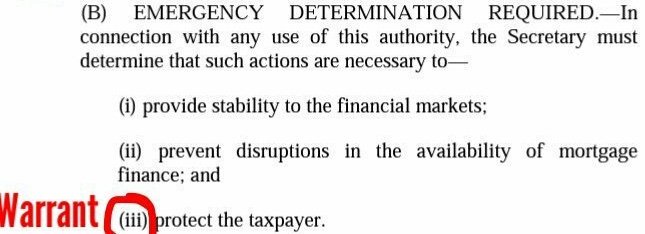Friday, February 23, 2024 2:53:07 AM
It turns out that, in the Charter Act, it's called dividend rate for the SPS the Treasury was authorized to purchase (not even one security purchased, in an attempt to twist the Law. A telltale sign).
Subsection (c):
"To yield a return at a rate determined by the Secretary of the Treasury, taking into consideration the current average rate on outstanding marketable obligations of the United States as of the last of the last day of the month preceding the making of such purchase."
The $2.25B limit was de facto updated in the SPSPA which, in turn, was authorized by a homonymous second UST backup of FnF, inserted by HERA in the Charter Act, subsection (g), with a deadline on December 31, 2009.
A dividend payment is a capital distribution restricted. The statutory exceptions kicked off. Then, the July 20, 2011 CFR 1237.12 that "supplements and shall not replace any other restriction on capital distributions by statute". Back to square one: Restricted. So, what the FHFA Acting Director DeMarco did with this Final Rule, is to insert more exceptions to the same restriction and the reason why this is an ongoing plan, now through another capital distribution (SPS LP increased for free): it's applied towards Recap in a separate account (outside the balance sheets). An External Position.
Obviously, the original rate on "any obligation, including the SPS (SPSPA)" prevails once it's assessed the cumulative dividend rate that has been restricted all along, as per the Charter dynamics: a UST backup to finance their operations as a last resort. Section: statutory purposes, where is set forth their Public Mission. You don't need to be wise to understand that both are intertwined if this "Public Mission" makes them take on more risk and not appropriately compensated.
-Provide ongoing assistance to the secondary market for residential mortgages: a countercyclical role.
- Activities relating to mortgages on housing for low- and moderate-income families involving a reasonable economic return that may be less than the return earned on other activities.
The authorization of purchase of securities of FnF in the Charter Act, isn't meant to purchase the FnF MBSs held by Blackrock on the open market as the Treasury stated in its MBS purchases program in 2009, claiming that it was this amendment inserted by HERA in the Charter Act

, but an authority to finance the operations of FnF, purchasing securities from them. Otherwise it would have been written in a congressional Charter for Blackrock among others, which doesn't exist. It's not that the Treasury got it wrong, but a deliberate attempt to twist the Charter Act and its dynamics.
We don't need these "innovative" solutions by attorney-mercenaries that are just selling smoke and don't even know that the Treasury can charge a dividend rate for the taxpayer's assistance.
Avant Technologies Engages Wired4Tech to Evaluate the Performance of Next Generation AI Server Technology • AVAI • May 23, 2024 8:00 AM
Branded Legacy, Inc. Unveils Collaboration with Celebrity Tattoo Artist Kat Tat for New Tattoo Aftercare Product • BLEG • May 22, 2024 8:30 AM
"Defo's Morning Briefing" Set to Debut for "GreenliteTV" • GRNL • May 21, 2024 2:28 PM
North Bay Resources Announces 50/50 JV at Fran Gold Project, British Columbia; Initiates NI 43-101 Resources Estimate and Bulk Sample • NBRI • May 21, 2024 9:07 AM
Greenlite Ventures Inks Deal to Acquire No Limit Technology • GRNL • May 17, 2024 3:00 PM
Music Licensing, Inc. (OTC: SONG) Subsidiary Pro Music Rights Secures Final Judgment of $114,081.30 USD, Demonstrating Strength of Licensing Agreements • SONGD • May 17, 2024 11:00 AM










